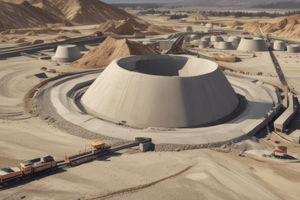Podcast
Questions and Answers
What is the primary purpose of cone clutches?
What is the primary purpose of cone clutches?
- To cool down engines
- To generate electricity
- To steer vehicles
- To engage or disengage power transmission (correct)
What are the key elements at the heart of a cone clutch?
What are the key elements at the heart of a cone clutch?
- Spherical surfaces
- Rectangular surfaces
- Conical friction surfaces (correct)
- Cylindrical surfaces
How are the conical friction surfaces of a cone clutch lined?
How are the conical friction surfaces of a cone clutch lined?
- With plastic linings
- With aluminum linings
- With friction materials like steel-backed organic linings or carbon-fiber-reinforced composites (correct)
- With copper linings
What design feature allows for the adjustment of friction surfaces in cone clutches?
What design feature allows for the adjustment of friction surfaces in cone clutches?
In cone clutch designs, what role do springs typically play?
In cone clutch designs, what role do springs typically play?
What type of clutch system are cone clutches classified as?
What type of clutch system are cone clutches classified as?
What is the role of the spring force in a cone clutch?
What is the role of the spring force in a cone clutch?
Where are cone clutches commonly used?
Where are cone clutches commonly used?
What advantage do cone clutches offer over other types of clutches?
What advantage do cone clutches offer over other types of clutches?
Which feature is NOT associated with cone clutches?
Which feature is NOT associated with cone clutches?
Why are cone clutches particularly suitable for racing applications?
Why are cone clutches particularly suitable for racing applications?
How do hydraulic control systems affect the operation of cone clutches?
How do hydraulic control systems affect the operation of cone clutches?
Study Notes
Cone Clutches: A Closer Look at Their Design
Cone clutches are a type of friction-based clutch system, commonly found in automotive and industrial applications. These clutches employ the friction between conical friction surfaces to engage or disengage power transmission. In this article, we'll delve into the design of cone clutches, exploring the key elements that make them effective in various settings.
The Conical Surfaces
At the heart of a cone clutch is a pair of conical friction surfaces. One surface, called the cone, is fixed and attached to a housing. The other surface, called the cone pad or lining, is attached to a rotating assembly, such as a flywheel or rotator, and is designed to engage or disengage the cone. The conical surfaces of the clutch are lined with friction materials, such as steel-backed organic linings or carbon-fiber-reinforced composites, which produce friction when the clutch is engaged.
Adjustable Friction Surfaces
One of the key design features of cone clutches is the ability to adjust the friction surfaces. This is achieved by incorporating a mechanism that allows the cone to be adjusted relative to the cone pad. This mechanism may include a screw or a linkage system that enables the cone to move axially along its axis, thereby adjusting the cone angle and the friction between the surfaces.
Spring Loading
In many cone clutch designs, springs are used to apply a compressive force between the conical surfaces. This spring force helps to maintain contact between the surfaces, even as the cone rotates. The spring force also helps to control the rate of engagement and disengagement of the clutch, which is particularly important in applications where smooth and precise control is required.
Hydraulic Control
Cone clutches can also be equipped with hydraulic control systems. In these systems, hydraulic fluid is used to exert force on a piston, which in turn moves the cone or the cone pad to engage or disengage the clutch. Hydraulic control systems are popular in applications where precise and quick control is required, such as in racing or other high-performance applications.
Applications
Cone clutches are widely used in a variety of applications, including:
- Automotive transmissions
- Industrial machinery
- Hydraulic systems
- Aerospace applications
- Racecars
Cone clutches are particularly well-suited for applications that require precise control over torque and speed. They are also well-suited for applications that require quick engagement and disengagement of power, such as racing or other high-performance applications.
Advantages of Cone Clutches
Cone clutches offer several advantages over other types of clutch systems, including:
- High torque capacity
- Precise control over torque and speed
- Quick engagement and disengagement
- Durability and reliability
- Adjustable friction surfaces
In summary, cone clutches are a versatile and effective type of clutch system, widely used in automotive and industrial applications. Their conical design, adjustable friction surfaces, and spring or hydraulic control systems enable them to provide high torque capacity, precise control over torque and speed, quick engagement and disengagement, durability, and reliability.
Studying That Suits You
Use AI to generate personalized quizzes and flashcards to suit your learning preferences.
Description
Delve into the design of cone clutches with this article, focusing on the conical surfaces, adjustable friction surfaces, spring loading, and hydraulic control systems that make them effective in various applications.




